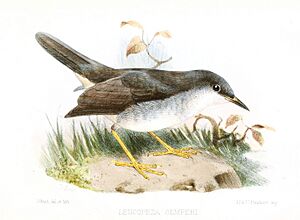Semper's warbler facts for kids
Quick facts for kids Semper's warbler |
|
|---|---|
 |
|
| Illustration by Joseph Smit | |
| Conservation status | |
| Scientific classification | |
| Genus: |
Leucopeza
|
| Species: |
semperi
|
The Semper's warbler (Leucopeza semperi) is a very rare bird that might even be gone forever. It is a type of New World warbler. This bird only lives on the island of Saint Lucia, which is part of the Lesser Antilles in the Caribbean Sea.
The bird's common name and its scientific name, Leucopeza semperi, honor Reverend John E. Semper. He was an amateur bird expert who lived on Saint Lucia a long time ago.
Contents
What Does the Semper's Warbler Look Like?
This small bird is about 14.5 centimeters (about 5.7 inches) long. Adult Semper's warblers have dark gray feathers on their backs and grayish-white feathers on their bellies.
Younger birds look a bit different. They are brownish-gray on top and have a light, yellowish-brown color underneath. All Semper's warblers have long, pale yellow legs. Their call sounds like "tuck-tick-tick-tuck."
Where Does the Semper's Warbler Live?
The Semper's warbler is a special bird because it is only found on the island of Saint Lucia. This means it is "endemic" to Saint Lucia. It likes to live in quiet, untouched parts of the rainforest, especially in the lower mountain areas. It also lives in what are called "elfin woodlands." These are forests with small, twisted trees found at high elevations.
What Do We Know About Its Life?
Scientists do not know much about the daily life or habits of the Semper's warbler. However, they think it probably builds its nests on the ground.
Why Is the Semper's Warbler in Danger?
In the 1800s, the Semper's warbler was quite common. But in the 1900s, there were very few sightings of this bird. The last time someone reliably saw a Semper's warbler was in 1961.
There have been a few possible sightings since then, in 1965, 1972, 1989, 1995, and 2003. Even though these sightings are not confirmed, there is still a small hope that the bird might be rediscovered. This is because some of its natural home, or "habitat," still remains on Saint Lucia.
One big reason for the bird's decline was the introduction of mongooses to the island. Mongooses are small, furry animals that hunt other animals. Since the Semper's warbler likely nested on the ground, it would have been an easy target for these new predators. Another reason for its decline is habitat destruction, which means its forest home was being cut down or changed by people.
Images for kids



